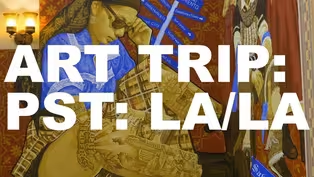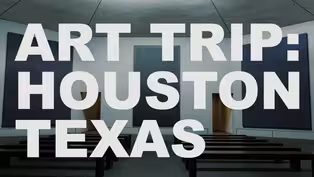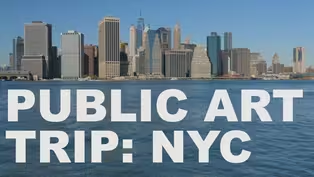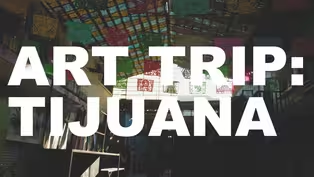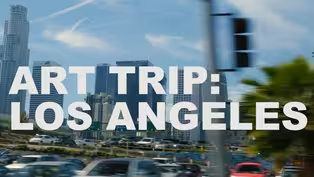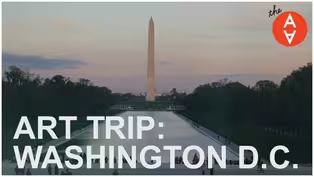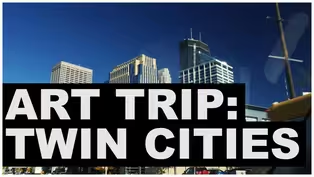
Art Trip: Indianapolis
Season 3 Episode 44 | 12m 36sVideo has Closed Captions
We figured it was time to come back home and try being tourists in our own town.
We've spent quite a bit of time exploring art in other people's cities, so we figured it was time to come back home and try being tourists in our own town.
Problems playing video? | Closed Captioning Feedback
Problems playing video? | Closed Captioning Feedback

Art Trip: Indianapolis
Season 3 Episode 44 | 12m 36sVideo has Closed Captions
We've spent quite a bit of time exploring art in other people's cities, so we figured it was time to come back home and try being tourists in our own town.
Problems playing video? | Closed Captioning Feedback
How to Watch The Art Assignment
The Art Assignment is available to stream on pbs.org and the free PBS App, available on iPhone, Apple TV, Android TV, Android smartphones, Amazon Fire TV, Amazon Fire Tablet, Roku, Samsung Smart TV, and Vizio.
Providing Support for PBS.org
Learn Moreabout PBS online sponsorshipMore from This Collection
Exploring cities' many fantastic art offerings.
Video has Closed Captions
We take a trip to LA and look at the Getty-funded initiative Pacific Standard Time: LA/LA. (20m 17s)
Video has Closed Captions
We take an art pilgrimage to Houston, Texas, and visit the likes of the Rothko Chapel, Jam (14m 4s)
Video has Closed Captions
For our second international art trip, we travel to London during Frieze Art Fair. (12m 31s)
Public Art Trip: New York City
Video has Closed Captions
New York City offers way too many art-viewing opportunities for us to cover in a single ep (7m 39s)
Video has Closed Captions
This week we travel to Tijuana to meet with Ghana Think Tank and Torolab. (13m 8s)
Video has Closed Captions
In which we explore sunny Los Angeles and take in its enormous range of art offerings. (8m 52s)
Video has Closed Captions
We explore Washington DC's vast collection of landmarks, museums, and galleries. (11m 8s)
Video has Closed Captions
In which we explore a few of Minnesota's many fantastic art offerings. (5m 22s)
Providing Support for PBS.org
Learn Moreabout PBS online sponsorshipWe've spent quite a bit of time exploring art in other people's cities, so we thought it was high time we gave the same treatment to our own.
But how does one attempt tourism in one's own town?
First, I recruited Stuart Hyatt, fellow resident and also superb sound artist, who has done quite a bit of city exploring as part of his work.
Second, we met up at a coffee shop to ditch our primary modes of transport, and see how much we could accomplish in a day without a car.
And third, well, coffee.
18 00:00:35,280 --> 00:00:37,500 We ordered Americanos at Kaffeine Coffee and sat down to plan our route.
We wanted to go full analog and use a paper map and did a fair bit of plotting that way until, well, it would have been silly not to use our magical devices at all.
We then walked down the road to pick up rental bikes at the closest Indiana Pacers Bikeshare pickup location.
You need to bring your own helmet, but the rest is fairly simple.
You'll see in the background the first of our many encounters with the work of past Art Assignment contributors.
Nat Russell of Fake Flyer fame was commissioned by a real estate development company to create a temporary public artwork to disguise slash beautify the construction site behind it.
You'll notice a fair bit of construction in this video because downtown Indy is in a bit of a boom cycle when it comes to development.
And a good portion of this development boarder's one of the city's newer amenities, the Cultural Trail, an eight mile biking and walking path that connects neighborhoods and cultural districts.
And the bikeshare is part of it too.
Along it, you'll pass a number of public artworks, including this mural of Indianapolis-based poet Mari Evans by artist Michael Alkemi Jordan.
One of her best known works is her 1970 poem "I am a Black Woman."
And it feels appropriate to recite its concluding stanza here.
50 00:01:58,560 --> 00:02:00,480 We kept going along Massachusetts Avenue and passed Julian Opie's "Ann Dancing," and Ann really is always dancing.
There is something supremely comforting about Ann dancing morning, noon, and night, through snow, rain, and presidential transitions.
That Ann, she never quits.
Just beyond, we encountered another literal literary giant.
This one a 38-foot tall Kurt, Vonnegut native son of Indianapolis.
Vonnegut said in 1986, what people like about me is Indianapolis.
So it's nice that he's here, although it hasn't gone unnoticed that he spent very little time here after leaving for college in 1940.
Then we rode over to "Prairie Module's 1 and 2," created by the art collective M12, which Stewart is part of.
They make works heavily informed by the context or place where they're working, and here, the trust formed structures reference both the covered bridges that parts of rural Indiana are known for, as well as the interstate infrastructure that gives Indianapolis its tagline, Crossroads of America.
Its green roof grasses are reminders of the surrounding prairie and its solar panels return power to the grid.
On we went to City Market, outside of which we found an artist design book share station that's part of an art and literacy project called the "Public Collection."
This really awesome, excellently functioning one made by Brose Partington was inspired by agricultural equipment and the linotype machine.
Stuart and I each picked up a book.
I snagged "My Daddy was a Pistol, and I'm a Son of a Gun," by Lewis Grizzard, for obvious reasons.
And Stuart picked up the classic "The House of the Spirits," by Isabel Allende.
Here's us comparing the last lines of each book, and I'll spare you the suspense and tell you mine won the contest.
I just hope heaven doesn't run out of camels and fried chicken.
Having extracted all we needed from our finds, we biked a few blocks to monument circle and returned the books to another lending station.
This one designed by Brian McCutcheon of Customize It fame.
Columns support an 1894 quote by Mark Twain extolling public libraries as the memorials that really last, preserving names and events, and also outlasting them.
A fitting sentiment for a city full of traditional memorials.
Then we headed south to the Alexander Hotel, home to a remarkable gathering of artworks commissioned specifically for the spaces.
You'll find an installation by Paul Villinski of birds cut from vinyl records emerging from a turntable.
Here, we also admire the work of Sonya Clark of our Measuring History's assignment, who created out of over 3,000 comb's a portrait of Indianapolis his own Madam CJ Walker, a haircare tycoon known as one of the first self-made millionairesses in America.
There are a number of other excellent works here but the piece de resistance is the bar and lounge by Jorge Pardo, who designed the colorful array of light fixtures that trail from the lobby into the lounge, and recall a school of fantastical sea creatures.
Pardo was also responsible for the patterned cement tiles and most of the furnishings, but he was not responsible for the amazing cocktails this place serves, which I was very sad we were too early for.
We then locked up our bikes and hopped in the car with Mark because Stuart got a tip from a friend that there was a lunchtime concert in 10 minutes over it at Eskenazi Hospital.
The new named campus of this public hospital opened in 2013, and along with featuring a number of artworks, it hosts a music program that on this day brought us the outstanding musical stylings of Indiana soul legend Lonnie Lester.
This concert, offered free of charge to whomever happened to be at the hospital that day, was thoroughly appreciated by those of us who stayed a while, as well as those who let a smile slip as they hurried on to an appointment.
The unexpected pleasure of Lonnie Lester, coupled with our walk through the gardens and plaza outside, made the hospital's stated goal of lifting spirits and promoting healthful living seem less like marketing and more like truth.
As we drove away, we enjoyed Rob Ley's parking structure facade, inspired by camouflage techniques and composed of thousands of metal panels that shift in appearance as you pass.
It was then back to our bikes and the Cultural Trail, which we followed along Virginia Avenue to experience an artwork by Acconci Studios led by Vito Acconci, who will never live down his renown for masturbating underneath the floor of an art gallery with visitors above in 1972.
Lucky for us, his work has taken a turn for the much less controversial, and he now leads a studio that realizes architecture and public space projects like this one.
In what used to be one of the darkest and most terrifying passageways in Indy, there is now Swarm Street, which activates as you pass through and illuminates thousands of LED lights embedded in the pavement and in a framework above.
You not only trace your own path, but you can see the paths of others generating either a sense of camaraderie with their fellow passers by or a helpful signal to pick up your pace.
It was beyond time for lunch when we made it to Fountain Square and stopped at Wildwood Market to ogle at all of the goods we couldn't carry with us and enjoy their delicious sandwich of the day.
With our blood sugar back at a functioning level, we were ready to see more art and headed to Indianapolis Museum of Contemporary Art, or IMOKA, as it's called around here.
They were hosting an exhibition titled Unloaded.
Here at the Murphey Building, as well as at their other location back near the Alexander, presenting works by a variety of artists all in some way exploring the form, image, and impact of guns in contemporary culture.
Mel Chin's "Cross for the Unforgiven" drew us in immediately, a Maltese cross made from cut and welded AK-47 assault rifles.
I also appreciated the dissonance of medium and subject matter in Stephanie Sy Juco's crocheted rifle, as well as my very visceral reaction to Andrew Ellis Johnson's finally detailed sculptural rendering of the maxim see no evil, hear no evil, speak no evil.
There's a lot of good work in this show, demonstrating the bottomless diversity of responses to a most American of issues.
We then headed upstairs in the Murphy Building, where you can find an eclectic and changing collection of artists studios, shops, and arcade, and music venues.
We were there to pay a visit to the tiny and mysterious Museum of Psychphonics, which occupies a small nook and contains, among other curiosities, a spaceship prop that was once part of Parliament Funkadelic's Mothership Connection stage show.
The museum is the brainchild of a group of local artists and musicians aiming to make a place that explores the interconnectedness of music, mystery, spiritual realms, pop culture, sci-fi, and the extraordinary.
It's exactly the kind of specific oddity that a bland leaning, chain restaurant loving city like Indianapolis needs.
While there, we also ducked into People for Urban Progress, an excellent nonprofit organization that rescues discarded materials and redesigns them for public benefit.
This has meant salvaging old stadium seats and repurposing them at bus stops throughout the city.
And it has also meant finding new uses for the 13 acres of fabric that used to serve as the roof for the former RCA dome here in town.
I decided it was high time I ditched my saddle backpack, so I purchased a lovely new drawstring bag made from dome fabric Super Bowl banner mesh and reclaimed seatbelts.
Although I did create a new problem of how to repurpose my old one.
Is there an Art Assignment for that?
Then we made a quick stop across the street to General Public Collective, an artist run project space and concept shop, which was then hosting an exhibition called Mr.
Sad Apple Skin Jacket, of amusing and impressive works by artist Lisa Berlin.
We enjoyed it, but then a sign told us it was OK to exit, so we did.
Back on our bikes we trekked on to the Garfield Park neighborhood to visit the new headquarters for Big Car Collective, who offered us the what, how, where assignment.
It's called the Tube Factory, and it's housed in, you guessed it, an old tube factory.
It's a community center as well as an exhibition space, and we caught the tail end of Detroit based artist Scott Hockings show, which was magnificent.
Continuing the repurposing theme of the day, Hocking's exhibition brought together materials found in a building that was once an RCA factory, and was most recently a recycling plant.
It was filled with materials that had been left there unrecycled until Hocking came along and spent weeks sorting through them and arranging selections of them in the tube factory space.
Massive hunks of burned Styrofoam form a mountain in the far end of the main gallery, and on the surrounding walls are mounted enthralling multi-hued plastic blobs.
Artists spent hours, days, months, and years pursuing the kind of formal and textural effects created here through the accident of industrial waste.
Hocking brings it together with brilliant economy.
Big Car is developing several buildings on this block, including the sound art space Listen Hear, which was still hosting Pablo Helguera's "Libreria Donceles," when we filmed the assignment Combinatory Play earlier in the year.
By this point, we were beat, so we biked to the nearest drop off point, and once again took comfort in Mark's gas powered ride.
We drove north and stopped by our favorite periodical shop Printtext, run by Benjamin and Janneane Blevins.
They've hosted a series of exhibitions here organized by curatorial collective AM called Syntax Season, featuring artists whose practices engage in various kinds of language games.
We were there for the month show with Jesse Malmed, whose show included daily called in excerpts from late night talk shows, as well as a theme song that plays out of a standing microphone.
The light and our spirits were fading, but we revived with iced coffee as Open Society and decided to end our day at 100 Acres, the art and nature park adjacent to the main campus of the Indianapolis Museum of Art.
Full disclosure, I am the opposite of objective about this particular space since I dedicated six years of my life to working for this museum and had a hand in the creation of the park.
It opened in 2010, and the whole idea of this place is to reconsider what an art park is supposed to be and do.
Called 100 Acres because it occupies 100 acres, the park features site specific installations, a visitor center designed by architect Marlin Blackwell, and a series of pathways designed to guide visitors through a landscape much less tamed than most museum parks.
The works here were created by artists from all over the world, each of whom had vastly different approaches to their contributions.
Very little in the way of text is provided on site, as you're meant to interact with what you find and seek answers online or in brochures, if you're so inclined.
I've had the privilege of getting to know this park over the course of many years, before there was art here, walking through it with artists on site visits, and as construction unfolded.
And now after, as it's become a valued refuge in the city.
So, yes, I am biased toward it, but isn't that always the case in the place where you live?
The longer you're there, the more ties you have to the people and places and objects that inhabit it.
So I couldn't look at this city with clear eyes, but I did have a great day within it.
I spent time with a friend, explored life without a car in this car dependent city, upped my backpack game considerably, and despite having visited all of these places before, still had surprises along the way.
After it was over, I realized nearly everything we visited had been created within the past 10 years, which made me equal parts grateful for this city's present and hopeful for its future.


- Science and Nature

A documentary series capturing the resilient work of female land stewards across the United States.












Support for PBS provided by:

